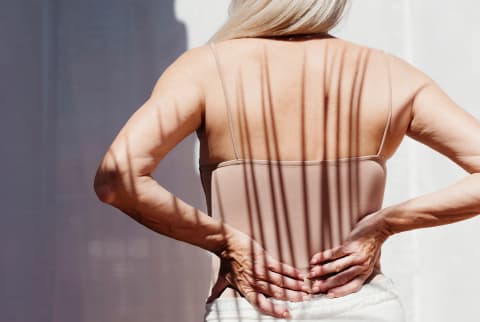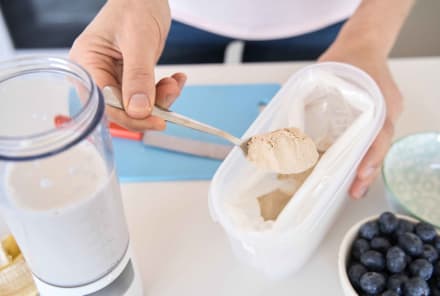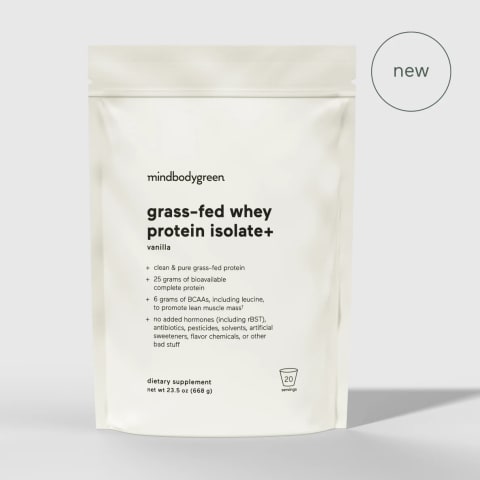Advertisement
Protein & Physical Activity Are The Biggest Indicators Of Muscle Loss For Women


Some muscle loss with age is to be expected—each decade after 30, muscle mass declines about 3-8%1 and accelerates even more around the age of 60. Losing more than this, in addition to strength and functionality of the muscle, is characteristic of sarcopenia, and that's a big concern for long-term health and quality of life.
Right now, sarcopenia is often evaluated using machinery (like MRI scans) or physical assessments that require specific training and may not be conducted unless there are clear signs something could be off. But by the time this testing happens, a lot of muscle (that could have been preserved) is lost.
So, researchers of a study investigated whether data on certain lifestyle habits could reasonably detect a heightened risk of sarcopenia2. And sure enough, looking at protein intake and physical activity were telltale signs of the condition, especially for women.
Here's what you need to know.
Why look at protein & physical activity?
Muscle tissue is dynamic, and muscle proteins are being broken down and created (or synthesized) simultaneously throughout the day.
Various factors associated with aging (including a loss of muscle fibers, loss of motor neurons, hormonal changes, inflammation, inactivity, and stress) tip the scale to muscle breakdown and make maintenance, let alone muscle growth, a challenge.
Protein and resistance exercise are the two factors that trigger muscle protein synthesis.
So researchers of this study collected data from 632 adults 65 or older on their typical protein intake over three days and the level of physical activity they engaged in. In addition, they also ran some assessments related to sarcopenia (such as chair stand tests, sit-to-stand tests, and grip strength) as well as body composition scans as more objective measures of sarcopenia risk for comparison.
Not meeting the recommendations is linked to an increased sarcopenia risk.
In total, 92 people were found to be at a high risk of sarcopenia as they ate less than the recommended amount of protein (about 1 gram per kilogram of body weight) and participated in less than the recommended 150 minutes3 of physical activity a week.
What's interesting is that women accounted for 77% of people in this category.
And while everyone deemed high risk based on these lifestyles had lower levels of lean mass and strength, the deficits were far more pronounced among women than men.
Why is this important?
Women have long been underrepresented in research—especially in studies related to muscle health—for decades. This study shows how women are more susceptible to poor muscle function with suboptimal diet and exercise, whereas men may be more protected from these declines.
Sarcopenia also isn't routinely assessed in primary care clinics. And assessment tools and tests can be costly and require special training that not all health professionals have.
Checking on a person's protein intake and physical activity is an easy, noninvasive way that would allow for early risk detection of a condition that often has a decades-long progression.
Because muscle mass can be better preserved with certain habits.
How to reduce your risk of sarcopenia
No medication prevents sarcopenia (or improves it once you start losing muscle) so the best prevention tactics are truly lifestyle choices:
- Strength train: Any movement is good movement, but resistant strength training (with or without weights) is especially important for stimulating muscle protein synthesis. And you don't need long sweat sessions at the gym to see results. "In reality, consistency is the key... If you strength train for 10 minutes, three days a week, you will improve longevity and functionality," board-certified obesity medicine physician Ali Novitsky, M.D., previously told mindbodygreen. Just carve out time for some aerobic activity (like walking) to hit the recommended minimum of 150 minutes of movement a week. If you're not sure where to start, check out our guide to strength training here.
- Eat enough protein: The researchers of this study used 1 gram per kilogram of body weight as the cutoff for getting enough protein. It should be used to determine the minimum amount of protein someone needs to maintain balance, but it's still likely falling short of what's needed to maintain optimal bone health. Instead, many experts recommend getting around 1.2-1.6 grams (even up to 2.2 grams sometimes) of protein per kilogram of body weight. Oftentimes, this breaks down to about 20-30 grams of protein per meal and 10-15 grams of protein per snack. Here are some easy tips for upping your protein intake.
- Choose high-quality proteins: Not only do you want to eat enough protein in general, but you also want to make sure you're choosing high-quality sources. While some plant foods are higher quality than others (like soy, for example), animal proteins win when it comes to how well the body is able to absorb them and use them for muscle protein synthesis. Chicken, beef, pork, and fish are all excellent sources of protein. Vegetarian options include Greek yogurt, cottage cheese, eggs, and whey protein. Yes, whey protein powders can be a convenient (and tasty) way to boost your protein intake. We rounded up our favorite whey protein powders here. They also contain the optimal amount of the amino acid leucine, which is a vital component of muscle protein synthesis. Plant proteins (supplements and food) do contain leucine, just smaller amounts that fall shy of the threshold needed to build muscle.
The takeaway
To combat accelerated muscle loss and sarcopenia, staying physically active and getting enough (high-quality) protein is absolutely key. This new study shows that women who don't maintain these habits are at an especially high risk of sarcopenia.
So the earlier that the risk can be identified and the more these habits are prioritized at a younger age, the more muscle, confidence, and strength we'll have walking into life's later decades.
Watch Next
Enjoy some of our favorite clips from classes
Enjoy some of our favorite clips from classes
What Is Meditation?
Mindfulness/Spirituality | Light Watkins
Box Breathing
Mindfulness/Spirituality | Gwen Dittmar
What Breathwork Can Address
Mindfulness/Spirituality | Gwen Dittmar
The 8 Limbs of Yoga - What is Asana?
Yoga | Caley Alyssa
Two Standing Postures to Open Up Tight Hips
Yoga | Caley Alyssa
How Plants Can Optimize Athletic Performance
Nutrition | Rich Roll
What to Eat Before a Workout
Nutrition | Rich Roll
How Ayurveda Helps Us Navigate Modern Life
Nutrition | Sahara Rose
Messages About Love & Relationships
Love & Relationships | Esther Perel
Love Languages
Love & Relationships | Esther Perel
What Is Meditation?
Box Breathing
What Breathwork Can Address
The 8 Limbs of Yoga - What is Asana?
Two Standing Postures to Open Up Tight Hips
How Plants Can Optimize Athletic Performance
What to Eat Before a Workout
How Ayurveda Helps Us Navigate Modern Life
Messages About Love & Relationships
Love Languages
Advertisement

Your Grandma's Go-To Supplement Is Once Again Popular (For A Good Reason)
Molly Knudsen, M.S., RDN

8 Dietitians Share The Nutrition Advice They Actually Follow
Molly Knudsen, M.S., RDN

Want To Build Muscle After 60? Make Sure You Get Enough Of This (Not Protein)
Molly Knudsen, M.S., RDN

Your Grandma's Go-To Supplement Is Once Again Popular (For A Good Reason)
Molly Knudsen, M.S., RDN

8 Dietitians Share The Nutrition Advice They Actually Follow
Molly Knudsen, M.S., RDN

Want To Build Muscle After 60? Make Sure You Get Enough Of This (Not Protein)
Molly Knudsen, M.S., RDN

Your Grandma's Go-To Supplement Is Once Again Popular (For A Good Reason)
Molly Knudsen, M.S., RDN

8 Dietitians Share The Nutrition Advice They Actually Follow
Molly Knudsen, M.S., RDN

Want To Build Muscle After 60? Make Sure You Get Enough Of This (Not Protein)
Molly Knudsen, M.S., RDN

Your Grandma's Go-To Supplement Is Once Again Popular (For A Good Reason)
Molly Knudsen, M.S., RDN

8 Dietitians Share The Nutrition Advice They Actually Follow
Molly Knudsen, M.S., RDN

Want To Build Muscle After 60? Make Sure You Get Enough Of This (Not Protein)
Molly Knudsen, M.S., RDN













